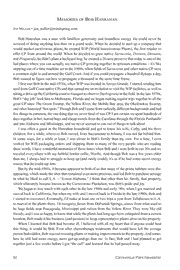
Memories of Bob Hanrahan PDF
Preview Memories of Bob Hanrahan
Memories of Bob Hanrahan Jim Mttt.fr •[email protected] Bob Hanrahan was a man with limitless generosity and boundless energy. He could never be accused ofdoing anything less than on a grand scale. When he decided to start up a company that would market carnivorous plants, he created WIP (World Insectivorous Plants), the first retailer to offer CP from around the world. When he decided to grow native Sarracenia, Drosera, Dionaea, andPinguicula,hedidn’tplantabackyardbog;he createda20-acrepreservethattodayis one ofthe lastplaces where you can actually see native CP growing together in optimum conditions - it’s like stepping out ofatime machine setto the 1960s,whenfields ofSarracenia andothernative CP were a common sight in andaroundthe GulfCoast.And ifyou couldpropagate ahundred flytraps aday, Bob wantedto figure out how to propagate athousand inthe same time frame. I firstmet Bob inthe mid-1970s, whenWIP was located inArroyo Grande. I started sendinghim seedfromGulfCoastnative CPsandthatearnedme aninvitationtovisittheWIP facilities, aswellas takingadriveuptheCaliforniacoasttoGasquettoobserveDarlingtoniainthefield. Inthelate 1970s, Bob’s “dayjob”tookhimto Melbourne, Floridaandwebeganmakingregulartripstogetherto allthe great CP sites: The Green Swamp, theYellow River, the Mobile Bay area, the Okefenokee Swamp, andotherhistorical“hotspots.”ThoughBobandIcamefromradicallydifferentbackgroundsandhad fewthings incommon, the onethingthatwenevertiredofwas CP. I amcertainwe spenthundreds of days togetherinhot, humidbogs andcheapmotels fromthe Carolinas throughthe FloridaPanhandle and intoAlabama andMississippi, andwe never seemedto runoutofthings to talkabout. I was often a guest in the Hanrahan household and got to know his wife, Cathy, and his three children. For a while, whereverBob moved, from Sacramento toAtlanta, I was not farbehind him. In some ways, for a while at least, I was closer to Bob’s family than my own. For a time, I even worked forWIP, packaging orders and shipping them to many ofthe very people who are reading these words. Ihavewonderfulmemories ofthosetimes whenBob andIwere bothinour30s andwe traveled everywhere withmy faithful border collie, Woofie. Andthough Bob was a fewyears older thanme, I always had to struggle to keep up (and rarely could); it’s as ifhe had some secret energy source that he couldtap into. Butbythe mid-1980s, itbecame apparentto bothofus thatmany oftheprimehabitats were dis- appearing,whichmadethe sitesthatremainedevenmoreprecious, andledBobtopurchase acreage in what he liked to call F.A. - “FowerAlabama.” I think that other than his family, that property, whichultimatelybecame knownas the Carnivorous Plantation, was Bob’s pride andjoy. We beganto lose touchwith each otherinthe late 1980s and early ‘90s, when I gotmarried and movedbackto California, butwhenmywife andImovedbacktoFloridainthe late 1990s, Bob and I started to reconnect. Eventually, I’d make at least one ortwo trips a year fromTallahassee to F.A. to marvel at the plants there. I’d recognizeflavas from DeFuniak Springs, alatas from what usedto be huge fields near Pascagoula, Mississippi and rubras from theYellow River. They were like old friends, andIwas sohappytoknowthatwhiletheplantshadlongagobeenextirpatedfromacertain location, Bob made it his business (andpassion) to keep representativeplants alive onhis property. When I learned that Bob had become ill, I believed with all my heart that ifanyone could beat this thing, it would be Bob. Even after chemotherapy treatments that would have left the average personbed-ridden,Bobwasoutrescuingplants ormakingimprovementstotheproperty.Andsome- how he still had more energy, more get-up-and-go than me. In fact, Bob and I had planned to get togetherjust a fewweeks before I got “the call” and learnedthat he hadpassed away. 92 Carnivorous Plant Newsletter Bob had some degree ofimpact on almost every person with a passion for carnivorous plants. His love ofCP and the Carnivorous Plantation he so carefully cultivated are his legacy, and I am sure there will be plants growing 50 or even 100 years from now that wouldnever exist were it not forBob Hanrahan. I surely do hope thatthe “betterplace” we are all supposed to go to one daywill be hot and humid with towering afternoon thunderstorms and Sarracenia stretching out as far as the eye can see. ERRATUM The correct name for the hybrid butterwort PlNGUICULA GRANDIFLORA SUBSP. ROSEA X P. VULGARIS Jan Schlauer •[email protected] Aymeric Roccia (2013) described a new hybrid butterwort from the Alps ofIsere, SE France. Unfortunately, the present author did not have a chance to review the manuscript before the article went to print, so a nomenclatural problem was overlooked. The new hybrid involves a subspecies different from the type subspecies ofPinguicula grandiflora (viz., P. grandiflora subsp. rosea) as a parent, while the analogous hybrid ofthe type subspecies ofP grandiflora was already described earlier under the legitimate name P x scullyi (Druce 1922). The new hybrid can thus not receive a name different from P x scullyi at species rank as originally proposed by Roccia (cf ICN, Art. H.5.2. “Ifthe postulated or known parent taxa are ofunequal rank the appropriate rank ofthe no- thotaxon is the lowest ofthese ranks”, McNeill et al. 2012). Subspecies rank is appropriate in the present case, andthe formally correct name is: Pinguicula xscullyinothosubsp. gresivaudanica (Roccia) J. Schlauer comb. & stat. nov. Basionym: Pinguicula xgresivaudanica Roccia, Carniv. PI. Newslett. 42(2): 37 (2013) References: Druce, G.C. 1922. Secretary’s Report for 1922. The Botanical Society and Exchange Club ofthe BritishIsles 6: 159. McNeill,J., Barrie,F.R.,Buck,W.R.,Demoulin,V, Greuter,W.,Hawksworth,D.L.,Herendeen,P.S., Knapp, S., Marhold, K., Prado, J., Prud‘homme van Reine, W.F., Smith, G.F., Wiersema, J.H., andTurland, N.J. 2012. International Code ofNomenclature forAlgae, Fungi, and Plants (ICN, Melbourne Code). RegnumVegetabile 154. Koeltz Scientific Books, Koenigstein, Germany. Roccia,A. 2013.Pinguicula xgresivaudanica (Lentibulariaceae), anewbutterworthybridfromthe FrenchAlps. Carniv. PI. Newslett. 42(2): 36-46. Volume 42 September 2013 93
